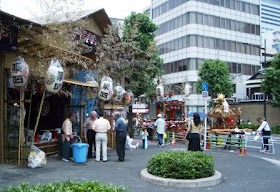Th' infernal
Serpent; he it was, whose guile
Stird up with
Envy and Revenge, deceiv'd
The Mother of
Mankind, what time his Pride
Had cast him out
from Heav'n, with all his Host
Of Rebel Angels,
by whose aid aspiring
To set himself
in Glory above his Peers,
He trusted to
have equal'd the most High,
If he oppos'd;
and with ambitious aim
Against the
Throne and Monarchy of God
Rais'd impious
War in Heav'n and Battel proud
With vain
attempt. Him the Almighty Power
Hurl'd headlong
flaming from th' Ethereal Skie
With hideous
ruine and combustion down
To bottomless
perdition, there to dwell
In Adamantine
Chains and penal Fire,
Who durst defie th' Omnipotent to Arms.
Killing time a few years ago, whilst idly
wandering about the city of Madrid, somewhat unexpectedly, I suddenly found myself
feeling a certain sympathy for the Devil.
Madrid is the perfect city for meandering around on foot. It is one of Europe’s foremost centres of the arts and culture, filled with literary and historical associations, a perfect place for contemplation. The labyrinthine paths of El Retiro lend themselves to just such a sense of natural reflection. On the several occasions I have previously visited Madrid the Retiro is somewhere I always go.
Madrid is the perfect city for meandering around on foot. It is one of Europe’s foremost centres of the arts and culture, filled with literary and historical associations, a perfect place for contemplation. The labyrinthine paths of El Retiro lend themselves to just such a sense of natural reflection. On the several occasions I have previously visited Madrid the Retiro is somewhere I always go.
El Retiro, or to give it its full title – Parque del Buen Retiro, the ‘Park
of Pleasant Retreat’ – is the largest green space within the Spanish Capital.
It dates back to the 1500s, and has a long historical association with the
Spanish Royal Household, but was first opened to the public in 1767 and finally
passed into public ownership in 1868. It is filled with beautiful tall trees, shrubs
and flower gardens, with many fountains, artificial lakes, sculptures, and some
interesting architectural features, such as the monumental colonnade of the Monumento a Alfonso XII, and the wonderful Palacio de Cristal, or ‘Crystal
Palace’ (said to have been modelled on the much larger one built in London’s
Hyde Park for the Great Exhibition of 1851). But for me the most interesting
feature of the park is a curious bronze statue, set high upon a stone pedestal
above a fountain – the Fuente del Ángel Caído, or the
‘Fountain of the Fallen Angel’.
The statue is commonly
purported to be the only publicly authorised depiction of Satan or Lucifer
anywhere in the world. First created in plaster by the sculptor, Ricardo Bellver (pictured right), for the Spanish National Fine Arts Exhibition in 1878, in which it won
First Medal, it was subsequently cast in bronze for the 1878 World Fair in
Paris. The nearby Museo del Prado later donated the statue to the city, and so
it was placed upon a stone plinth surmounting a fountain decorated with various bronze
gargoyles each devouring various lizards and serpents, designed by Francisco Jareño. The sculpture of the
diabolical winged figure reeling back, with struggling limbs wreathed in
serpents, shouting angrily at the sky above, which bears a very strong
resemblance to a depiction (c.1866) of the same theme by the artist Gustav Doré, is said
to have been inspired by the passage describing Satan’s fall from Heaven in the
first Canto of John Milton’s Paradise Lost (first published in 1667, with a final revised version appearing in
1674).
Milton’s Paradise Lost is a
curious work. An epic poem written in blank verse, it describes how Satan,
having been cast out of Heaven after a battle with God, travels on an arduous
journey to the Garden of Eden on a quest to tempt Adam and Eve to defy God’s
Will and eat from the Tree of Knowledge, thereby precipitating mankind’s fall
from Grace and Satan’s own retreat into perdition. It is a heavy going poem in
parts, but it is certainly a rewarding read, and it has given the English
language some of it’s more memorable and quotable lines, such as: “All is not lost …” and “Better to reign in Hell, than serve in
Heaven.”
Milton was, of course, a prominent figure in the Puritan Revolution
which briefly succeeded in making England a Republic under Oliver Cromwell when
the Parliamentarian Forces won the English Civil War in 1651. Milton supported the
regicide of King Charles I, and, as such, the sentiments so eloquently
expressed in the poem by Satan against the hypocrisy and tyranny of God are
often thought to reflect this republican stance – yet, Paradise Lost, by the very nature of its subject, poses a bit of an
unfathomable and even somewhat dangerous conjecture; for how can a Puritan Christian
using such a metaphor for monarchy not thereby also deny the infallible
supremacy of God? ... It’s a point which literary scholars have debated
strongly, alongside the conundrum as to whether or not Satan is, or should be
thought of as the central ‘hero’ of the poem.
I confess, I certainly don’t know enough about the English Civil War,
nor about Milton for that matter, to have a definite view on these contentious
questions – but, having read Paradise
Lost once, it has significantly hooked my intrigue, and as such it is
definitely a work which I know I shall one day return to and read again.
Certainly, my first reading of it was fairly beguiling and left me feeling
puzzled. I knew Milton was a staunch Puritan and a supporter of republicanism,
but reading the lines which speak so clearly against the tyranny of God I
couldn’t help but reflect on his political proximity to Oliver Cromwell,
England’s Lord Protector, “warts and all”
– a different, but nonetheless de facto,
kind of dictator. I suspect I may well be reading too much of my own half-informed
suppositions back into his poem, but this metaphorical tangle did seem somewhat
baffling.
What little I know of Milton is actually gleaned from my readings about Andrew Marvell,
the politician who is now best remembered as an exceptionally
fine poet. The ‘Metaphysical Poets’, with whom Marvell is now grouped, along
with the ‘Romantics’ are my most favourite schools, and I often re-read much of
their work; hence why I perhaps feel an affinity for the Romantics’
interpretation of Milton’s epic over those of theologically inclined critics
such as C.S. Lewis, who argued that there was no such conceptual conflict and that
Milton’s conception of God could easily be disassociated from his views of
Charles I (and what of Cromwell?), whereas William Blake espoused that: “The reason Milton wrote in fetters when he
wrote of Angels & God, and at liberty when of Devils & Hell, is because
he was a true Poet and of the Devil's party without knowing it.” … It is, as I'd agree, a much more tempting entertainment to let one’s self succumb to a certain
Byronic sympathy for the Devil, after all!
Both Milton and Marvell survived the Restoration, with Marvell, it is
said, succeeding in persuading the government of King Charles II not to execute
Milton for his anti-monarchical writings and revolutionary activities. Marvell
however remained ‘in opposition’ all his life to the corruption which he saw as
rife within the Royal Court, penning anonymous works of eloquent satire upon
the theme, the extreme sensitivity of which meant they could not appear in
print under his name until well after his death.
I’d love to know more about how and why Ricardo Bellver chose Milton’s ‘Fall
of Satan’ as his subject for the sculpture in Madrid’s Retiro. There may, of
course, be nothing much to it ... But it was, and in many ways, it remains an
original subject to depict; and, naturally, certain stories will always arise
around such curiosities – for instance, it is said that purely by chance Jareño’s
stone pedestal has unwittingly set Bellver’s statue at precisely 666 metres
above sea-level. But if such monuments tend somewhat inevitably to accrue a Dan Brown-esque tinge of ‘sub-mythification’, it doesn’t take too much
over-interpretation to appreciate the curious fact that to this day a statue of
Cromwell, that most contentious of English statesmen, still presides over
Parliament Square in London, when you know that he is watched over by a
craftily concealed ‘head’ of Charles I which is mounted over a sealed doorway
of the nearby Church of St Margaret (see here). Even when immortality is perhaps
gained in bronze, to be cast out of Heaven is to be an outcast for all
eternity.
All is not lost;
the unconquerable Will,
And study of
revenge, immortal hate,
And courage
never to submit or yield:
And what is else
not to be overcome?
That Glory never
shall his wrath or might
Extort from me.
To bow and sue for grace
With suppliant
knee, and deifie his power,
Who from the
terrour of this Arm so late
Doubted his
Empire, that were low indeed,
That were an
ignominy and shame beneath
This downfall;
since by Fate the strength of Gods
And this
Empyreal substance cannot fail,
Since through
experience of this great event
In Arms not
worse, in foresight much advanc't,
We may with more
successful hope resolve
To wage by force
or guile eternal Warr
Irreconcileable,
to our grand Foe,
Who now
triumphs, and in th' excess of joy
Sole reigning holds the Tyranny of Heav'n.































